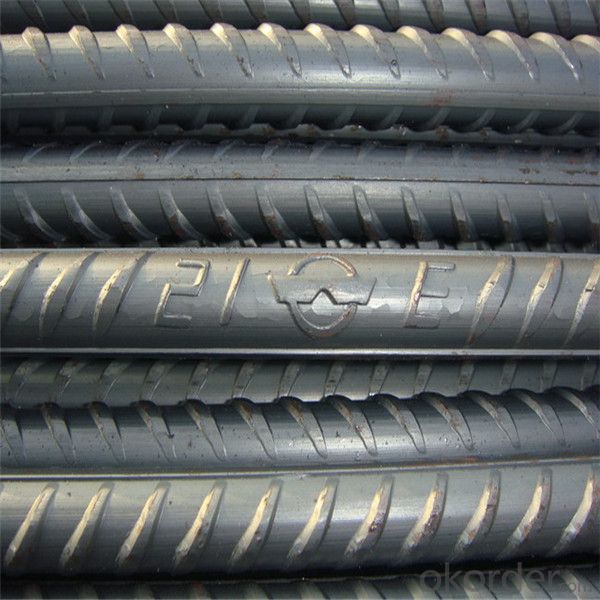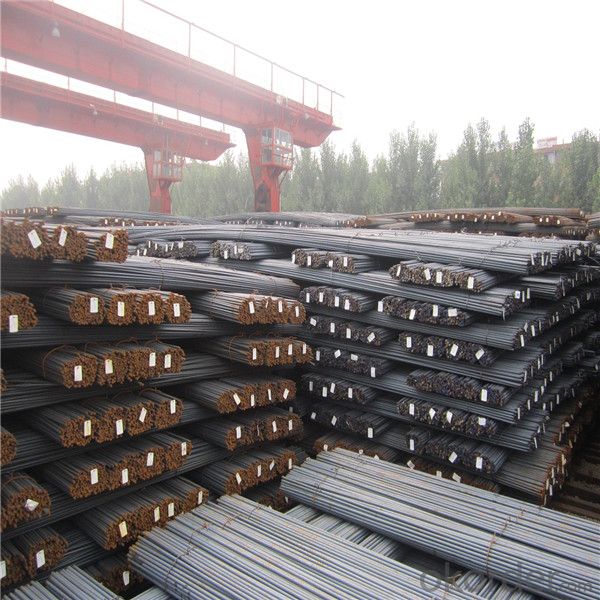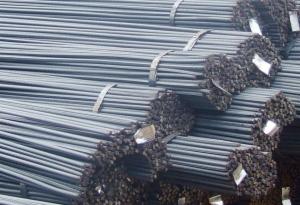HRB500 Deformed Steel Rebar for building
- Loading Port:
- Tianjin
- Payment Terms:
- TT OR LC
- Min Order Qty:
- 100 m.t.
- Supply Capability:
- 18000 m.t./month
OKorder Service Pledge
OKorder Financial Service
You Might Also Like
Specification
Rebar is common steel reinforcing bar, an important component of reinforced concrete and reinforced masonry
structures. It is usually formed from mild steel, and is given ridges for better frictional adhesion to the concrete.
Concrete is a material that is very strong in compression, but virtually without strength in tension. To compensate
for this imbalance in concrete's behavior, rebar is formed into it to carry the tensile loads.
Our Advantage: High quality steel products from 1 class mills in China
Reasonable price
Professionalism of the products
On-time delivery
Complete documents and certificates
Sincere service to meet our clients' requirements
Product Description :
Chemical composition (%): | Steel | C | Si | Mn | P | S | Ceq | ||||
HRB335 |
0.25 |
0.80 |
1.60 |
0.045 |
0.045 | 0.52 | |||||
HRB400 | 0.54 | ||||||||||
HRB500 | 0.55 | ||||||||||
Mechanical properties | Steel | Rel/ MPa | Rm/ MPa | A/ % | Agt/ % | ||||||
≥ | |||||||||||
HRB335 | 335 | 455 | 17 |
7.5 | |||||||
HRB400 | 400 | 540 | 16 | ||||||||
HRB500 | 500 | 630 | 15 | ||||||||
Package: | Standard export packing or as customer's request | ||||||||||
Application: | Construction, building, bridge, road. ect | ||||||||||
Payment terms | 1).100% irrevocable L/C at sight. | ||||||||||
Delivery time | 15-30 days after receipt of L/C or deposit by T/T | ||||||||||


Packing:
In bundles, each bundle weight 3.5 tons. Load by container or by bulk verssel.


Our service
(1) We cooperate with famous factories with advanced equipment and well trained workers.
(2) We can provide factory price with trading company service.
(3) We continuously work on the improvement of our processes, guaranteeing consistently high standards
of quality to keep none compensation.
(4) We guarantee 24 hours response and 48 hours solution providing service.
(5) We accept small order quantity before formal cooperation.
(6) We deliver the agreed quality at the agreed time, reacting to changes in customer wishes in a flexible way.
(7) Due to our volume and selling power, we have excellent freight rates with shipping lines.
(8) We strive to always be fair and honest in our dealings with customers.
(9) We strive to work together with customers to achieve much more than we can achieve alone.
(10) Through our passion and commitment we aim to be a market leader in all our key markets. To maintain
our position as market leader we must continue to add value in all that we do.
FAQ:
1.Q: What's your MOQ(minimum order quantity)?
A: One full container, mixed acceptable .
2. Q: What's your packing methods?
A: Packed in bundle or bulk ..
3. Q: How can I buy CNBM products in my country?
A:Please send us an inquiry or email ,we will reply to you if there is distributor in your country
4. Q: Can we visit your factory?
A: Warmly welcome. Once we have your schedule, we will arrange the professional sales team to follow up your case.
5. Q: How long does it take to get the product if i place an order?
A:With the process of your requirements,we will pack and deliver in 3-7 days. If it is by sea shipment,it will take 15-45 days depending on different locations
- Q: How are steel rebars spliced or connected in construction joints?
- Various methods are used to splice or connect steel rebars in construction joints, ensuring the integrity and strength of reinforced concrete. A common method is lap splicing, where rebars are overlapped and then mechanically connected or tied together with steel wires or couplers. The required overlap length for lap splicing depends on the rebar diameter and design specifications, often specified as a multiple of the diameter. This length guarantees efficient load transfer and prevents potential failures at the connection point. Mechanical couplers offer an alternative method for splicing rebars. These pre-fabricated devices securely connect two rebars, eliminating the need for lap splicing and providing a more precise and reliable connection. Mechanical couplers are particularly useful when dealing with larger rebar sizes or when long lap lengths are not feasible. In certain cases, welded splicing may be used. This method involves welding the ends of rebars together, creating a solid and continuous connection. Welded splicing is commonly employed when dealing with larger diameter rebars and higher load requirements. However, it is crucial to adhere to proper welding techniques and practices to maintain the connection's integrity. Overall, the splicing or connection of steel rebars in construction joints is a crucial aspect of reinforced concrete construction. It ensures that rebars function as continuous reinforcement, enabling structures to effectively resist applied loads. The choice of splicing method depends on factors such as rebar size, design specifications, and project requirements.
- Q: Can steel rebars be used in thin concrete elements?
- Yes, steel rebars can be used in thin concrete elements. Rebars provide tensile strength to concrete, preventing cracks and enhancing its structural integrity. However, it is important to ensure proper spacing and cover requirements to avoid corrosion and maintain durability.
- Q: How do steel rebars affect the seismic performance of a structure?
- The seismic performance of a structure is significantly impacted by steel rebars. Steel rebars have the primary function of reinforcing concrete and increasing its strength and ductility. This reinforcement is essential in reducing the damaging effects of seismic activity. When an earthquake occurs, a structure is subjected to different forces, such as lateral forces, shear forces, and bending moments. These forces can cause deformation, cracking, or even collapse of the structure. However, steel rebars provide resistance against these forces and help maintain the integrity of the structure. By increasing the tensile strength of concrete, steel rebars enhance its ability to withstand the lateral movement caused by seismic waves. This allows for a more even distribution of forces, minimizing the formation and propagation of cracks and reducing the risk of structural failure. Additionally, steel rebars improve the ductility of the structure. Ductility refers to a material's ability to deform without breaking. During an earthquake, the shaking of the ground can cause the structure to deform and oscillate. Steel rebars enable the structure to absorb and dissipate energy, decreasing the chances of sudden failure. This ductile behavior is particularly important in areas prone to earthquakes as it provides warning signs of potential structural distress, allowing occupants to evacuate safely. Moreover, steel rebars can be strategically placed in critical areas of the structure, such as the beam-column joints, which are highly vulnerable during seismic events. Proper detailing and configuration of rebars in these areas can greatly enhance seismic performance by strengthening connections and preventing premature failure. In conclusion, steel rebars play a critical role in improving the seismic performance of a structure. They enhance the tensile strength of concrete, improve ductility, reduce crack formation, and strengthen critical areas. These factors collectively contribute to a more resilient structure that can better withstand and absorb the forces generated during an earthquake, ultimately ensuring the safety and stability of the building and its occupants.
- Q: How do steel rebars affect the overall durability of concrete?
- Steel rebars have a significant impact on the overall durability of concrete structures. The presence of steel rebars in concrete enhances its strength and resistance to various external forces and environmental conditions. One of the primary functions of steel rebars is to provide tensile strength to concrete, which is otherwise weak in resisting tension. Concrete is excellent in compression but tends to crack under tension. By embedding steel rebars within the concrete, these cracks are effectively controlled and prevented from expanding, thus improving the durability of the structure. Steel rebars also help in increasing the flexural strength of concrete, making it more capable of withstanding bending and deformations. This is particularly crucial in structures such as beams, columns, and slabs that experience significant loads and forces during their lifespan. Moreover, steel rebars act as a reinforcement in concrete, improving its resistance to external factors such as earthquakes, wind, and impact loads. The presence of rebars helps in distributing and dissipating these forces throughout the structure, reducing the chances of structural failure and increasing the overall durability. Another critical aspect is the prevention of corrosion in reinforced concrete structures. The steel rebars are typically coated with materials that protect them from corrosion caused by moisture and chemical reactions. This protective coating, coupled with the alkaline environment of concrete, creates a barrier that significantly slows down the corrosion process, thereby increasing the longevity and durability of the concrete structure. In conclusion, steel rebars play a vital role in enhancing the overall durability of concrete structures. They provide the necessary tensile strength, improve flexural strength, enhance resistance to external forces, and prevent corrosion. By incorporating steel rebars, concrete becomes more robust, long-lasting, and capable of withstanding various challenges, ensuring the longevity and safety of the structure.
- Q: Can steel rebars be used in sound barrier walls?
- Yes, steel rebars can be used in sound barrier walls. Steel rebars provide structural strength and stability to the walls, making them suitable for withstanding external forces and vibrations. Additionally, the steel rebars help in reinforcing the concrete used in the walls, enhancing their durability and longevity.
- Q: What is the difference between carbon steel and stainless steel rebars?
- The main difference between carbon steel and stainless steel rebars lies in their composition and corrosion resistance. Carbon steel rebars are made primarily of iron and carbon, while stainless steel rebars contain iron, chromium, and other alloying elements like nickel and molybdenum. Carbon steel rebars are more susceptible to corrosion compared to stainless steel rebars, especially in environments with high moisture or exposure to chemicals. Stainless steel rebars, on the other hand, have a higher resistance to corrosion due to the presence of chromium, which forms a protective oxide layer on the surface. This makes stainless steel rebars suitable for applications in harsh or corrosive environments, such as marine structures or concrete exposed to chloride ions. Additionally, stainless steel rebars have higher tensile strength and ductility compared to carbon steel rebars. This makes them more suitable for structural applications where high strength and durability are required. Overall, the choice between carbon steel and stainless steel rebars depends on the specific application and the level of corrosion resistance and strength needed.
- Q: What is the average weight of steel rebars per meter?
- The average weight of steel rebars per meter can vary depending on the specific size and type of rebar being used. However, as a general guideline, a common size of rebar such as a #4 (1/2 inch diameter) typically weighs around 0.668 kilograms per meter, while a #8 (1 inch diameter) can weigh approximately 2.67 kilograms per meter. It is important to consult the manufacturer or reference a reliable source to obtain the accurate weight of steel rebars per meter for a specific size and type.
- Q: Can steel rebars be used in heritage building restoration?
- Yes, steel rebars can be used in heritage building restoration. Steel rebars provide strength and structural support, making them an ideal choice for reinforcing deteriorated or damaged sections of heritage buildings. However, it is important to consider the specific requirements and guidelines set by heritage preservation authorities to ensure that the restoration process maintains the historical integrity of the building.
- Q: How are steel rebars coated with epoxy?
- Epoxy coating, also known as epoxy rebar coating, is utilized to coat steel rebars for the purpose of protection against corrosion and other environmental factors. To initiate the process of coating steel rebars with epoxy, the first step involves preparing the surface. This essential stage entails the thorough cleaning of the rebars to eliminate any dirt, oil, or rust present. The significance of surface preparation lies in ensuring proper adhesion of the epoxy to the steel surface. Once the surface is adequately prepared, the application of the epoxy coating commences. There are various methods available for this application, including spraying, brushing, or dipping the rebars into an epoxy solution. The choice of method depends on factors such as the rebars' size and shape, as well as the desired thickness of the epoxy coating. Subsequent to the application of the epoxy, the rebars are allowed to cure. Curing is the process during which the epoxy hardens and attains its maximum strength. The duration of this process may vary depending on the specific epoxy product utilized, but it generally takes several hours or even days for the epoxy to fully cure. Upon achieving complete curing, the coated rebars are prepared for use. The epoxy coating acts as a protective barrier, effectively preventing the steel rebars from rusting and deteriorating over time. Additionally, it enhances the rebars' resistance to chemicals, moisture, and other corrosive substances. To summarize, epoxy coating proves to be an efficient method for safeguarding steel rebars against corrosion and extending their lifespan. It finds extensive application in construction projects wherein rebars are exposed to harsh environmental conditions, such as bridges, buildings, and infrastructure projects.
- Q: What are the guidelines for installing steel rebars in concrete columns?
- The guidelines for installing steel rebars in concrete columns typically include ensuring the proper spacing and alignment of the rebars, using appropriate reinforcement sizes and types, securely tying the rebars at intersections, providing sufficient cover for the rebars, and ensuring proper anchorage and lap length for effective structural integrity. It is also important to follow any specific regulations or requirements outlined by local building codes or project specifications.
Send your message to us
HRB500 Deformed Steel Rebar for building
- Loading Port:
- Tianjin
- Payment Terms:
- TT OR LC
- Min Order Qty:
- 100 m.t.
- Supply Capability:
- 18000 m.t./month
OKorder Service Pledge
OKorder Financial Service
Similar products
Hot products
Hot Searches
Related keywords


























